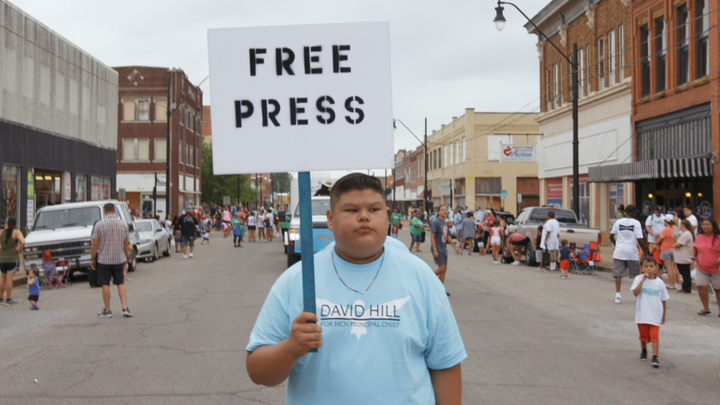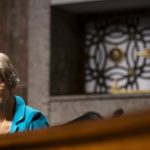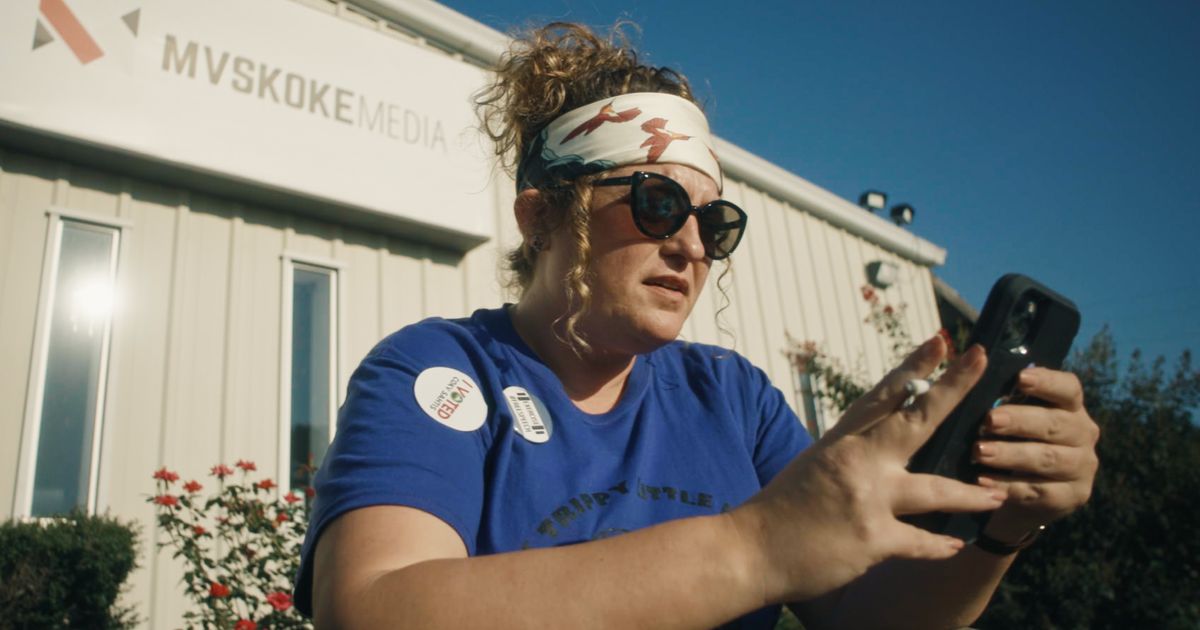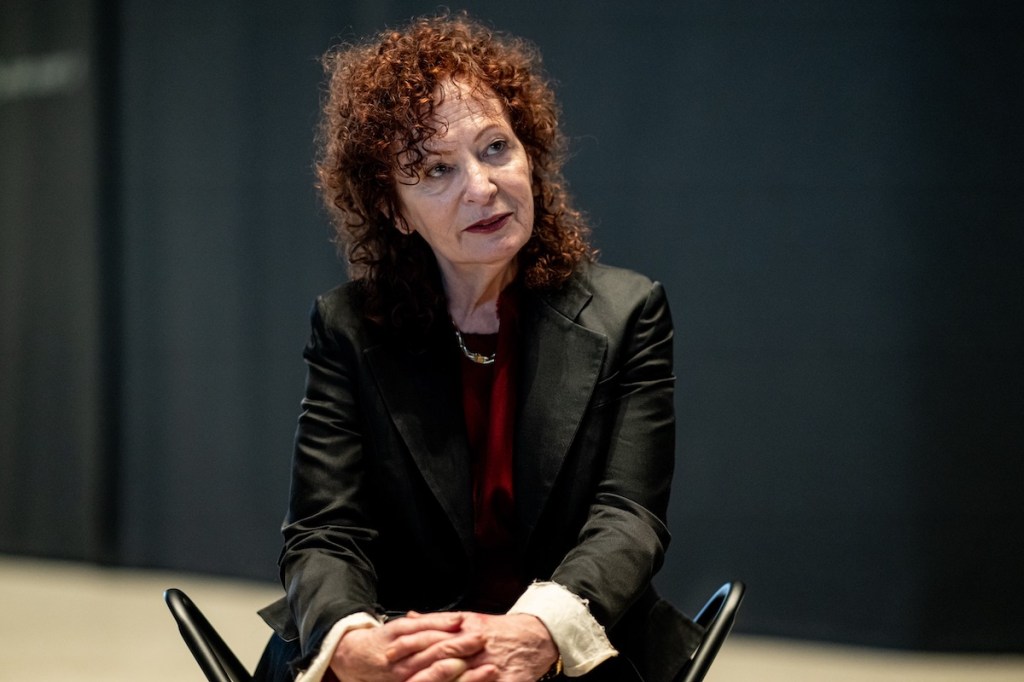In the fall of 2019, journalists at Mvskoke Media, the news outlet covering the Muscogee (Creek) Nation in Oklahoma, were documenting a dramatic election season while also facing a tough fight to safeguard their right to report the story.
When Lucian Tiger III, one of the contenders in the primary election for the office of principal chief, came 10 votes short of advancing to the runoff, he filed a motion for a recount and made accusations of voter fraud. Mvskoke Media reporters Angel Ellis and Jerrad Moore scrambled to report out the details, a scene captured in this HuffPost exclusive clip of the new documentary “Bad Press,” which will have its New York theatrical premiere this Friday.
The contested election is just one of several wild chapters of a years-long fight in the Muscogee Nation to restore and codify free press protections. It culminated in a landmark achievement in the fall of 2021, when the tribal nation’s citizens voted overwhelmingly to approve a free press constitutional amendment.
Of the 574 federally recognized Native tribes, just five have free press laws on the books. And as of now, the Muscogee Nation is the only one with the right to a free and independent press enshrined in its tribal constitution. The high stakes of the fight are rivetingly chronicled in “Bad Press.” The film, directed by Rebecca Landsberry-Baker and Joe Peeler, premiered at this year’s Sundance Film Festival, where it won the U.S. Documentary Special Jury Award for Freedom of Expression.
“Bad Press” begins in November 2018, when the Muscogee Nation’s National Council abruptly and narrowly repeals the tribe’s free press law, enacted in 2015. The tie-breaking vote is cast by Tiger, the council’s speaker. Overnight, Mvskoke Media turns into essentially a government publication. Without free press protections, tribal leaders get to sign off on what’s published each week. Most of the staff resign in protest.
It’s part of the tension long hampering Native journalists at tribal news outlets. As the documentary explains, in many Native tribes, especially those without free press laws in place, tribal leaders have a heavy hand in controlling and funding tribal media outlets. Indigenous journalists are frequently censored, there are relatively few independent tribal media outlets and some publications essentially become extensions of the tribe’s public relations department. There are historical reasons for this: Tribal leaders rightly wanted to counter the long history of offensive and stereotypical portrayals of Native people.
But as journalists like Ellis demonstrate, citizens should also demand free and independent reporting on their communities.
“What we cover is most important to Muscogee (Creek) people,” she says in the documentary. “But here I am, reporting on news topics that maybe don’t show my tribe in the best light. But do you want a friend who will lie to you and leave you walking out the door with a booger hanging out your nose and, you know, toilet paper on your shoe? Or do you want a friend that will stop you and say: ‘Hey, check your face’? That’s how I view my job as a journalist. But it’s a very fragile system right now. Even with the free press law, it’s still fragile.”
It’s likely not a coincidence that the council’s surprise move to repeal the free press law came after Ellis and her colleagues broke several major stories involving government corruption and misconduct. In fact, at the emergency session for the vote, one council representative, James Jennings, says the quiet part out loud. He explains that he supports the repeal because “the newspaper itself could have more positive issues on the nation and not so much negative issues with it.”
As Ellis recalls in the documentary: “The most pissed I’ve ever been in my life was to hear James Jennings talk about the bad news that’s been in the paper. Inside, I was just screaming: ‘Well, stop doing fucking bad things!’”
Her refreshing bluntness is among the reasons why “Bad Press” avoids a common pitfall of depictions of journalism. It can be a challenge to make such movies visually interesting, since journalists’ day-to-day tasks — phone calls, emails, typing at a desk — tend to be pretty mundane. It helps that humor is central to the daily experience of journalists, who are routinely “dealing with really stressful situations,” as Landsberry-Baker noted in an interview.
In addition, humor is a vital part of Indigenous cultures. “Just being able to laugh sometimes at all the ridiculous things that you’re dealing with is really a survival mechanism for Indigenous people, too,” she said. “There’s just such an interesting dynamic, which I was very excited as a director to be able to share this part of my community, that’s so special, with the world.”
Emily Assiran/Contour by Getty Images
Landsberry-Baker worked at Mvskoke Media for many years as a reporter, editor and editorial board member. Now the executive director of the Indigenous Journalists Association, she wanted to make “Bad Press” in order to shine a well-needed spotlight on the work of Native journalists and the obstacles they face when working without free press protections. She also hopes the film provides a visual blueprint for citizens of Native tribes to mobilize their own efforts to enact free press laws. In fact, it’s a major reason why, after working as a print journalist for so long, she thought a documentary was the best way to cover this story.
“There’s no print story that could have encompassed everything that happened over the four years of this journey,” Landsberry-Baker said. “I think it provides such a powerful storytelling format, especially for showing the diversity of our communities, showcasing the nuances and that we are a modern people. We’re not a monolith. It combats stereotypes of modern Native communities in a way that you just can’t do in any print form. I think the format of just being able to show people, versus tell them, what was happening, and then for them to be able to connect with a character like Angel — like, there’s just no way you can write Angel if you wanted to, and so I think it was really powerful to have her leading this fight and seeing the experience through her eyes on film.”
Visually, the film’s production team drew a lot of inspiration from the landscapes of Oklahoma, according to Peeler. Throughout filming, they were often spending hours each day driving around the state to follow the reporters and candidates. Along the way, they collected footage that became visual metaphors throughout the film.
When combined with the dramatic premise and high stakes, all of these elements create a constant sense of motion and suspense throughout “Bad Press.” Much of the film takes place during that contentious election season in 2019, when support for free press protections becomes a major campaign issue and litmus test for candidates. The council also considers whether to put a free press constitutional amendment on the ballot, but the proposal fails to advance.
There’s a version of the film that ended there. Landsberry-Baker and Peeler initially had aimed to finish the documentary in 2021, in time to premiere it at the 2022 Sundance Film Festival.
“It kind of ended on this wishy-washy title card that you’ve seen in a billion documentaries, which is: ‘Well, maybe one day, the Muscogee Nation will eventually present a constitutional amendment, and, you know, we hope the vote gets to the floor and that it gets to the people,’” Peeler said. “We were working toward that movie because we just thought, and I think everybody else in Mvskoke Media and, really, a lot of the citizens thought: ‘The constitutional amendment is never actually going to get brought to a vote of the people.’”
But documentaries, especially those that unfold over a number of years, can take a dramatic turn when real life intervenes. In a shift from two years earlier, in the summer of 2021, the council votes to put the constitutional amendment on the ballot for voters in that fall’s election. Meanwhile, tribal officials are continuing to censor the Mvskoke Media staff, including by denying them access to the ballot counting.
“And then we get a call out of the blue from Angel, and that’s in September of 2021. And she says, basically, ‘Shit’s hitting the fan,’” Peeler recalled. “I jumped on a plane faster than I ever jumped on a plane in my entire life. And basically the entire third act of the movie, our team went out and filmed in, like, five days. And it was a total surprise — a complete, complete surprise.”
Why was there such a sea change in two years from the constitutional amendment failing to advance out of the council to citizens getting to decide for themselves — and then overwhelmingly approving it? Landsberry-Baker attributes the shift to a confluence of developments that underscored the need for a free and independent news outlet. There was the COVID-19 pandemic and its disproportionate effect on Native communities, the implementation of the CARES Act economic stimulus to mitigate the pandemic’s fallout, distribution of the COVID vaccine and the 2020 U.S. Supreme Court ruling in McGirt v. Oklahoma that reaffirmed the Muscogee Nation’s reservation. Muscogee citizens realized what they were missing by not having a free press as an accountability mechanism.
“The citizens said, ‘Now more than ever, we need access to this news and information,’” Landsberry-Baker said. “I think it’s in those moments of political unrest that you see tribes pick up the torch for the fight for free press, and all five tribes that have added those protections, it has been during a kind of tumultuous political state.”
To the relief of Ellis and her colleagues, this year’s Muscogee Nation elections were much less tumultuous. And in a telling sign, several officials with a history of opposing free press protections were voted out, according to Landsberry-Baker.

“Bad Press” particularly resonates in a time when both press freedom and local journalism are in crisis. As of this year, more than 200 counties in the U.S. now have no local news outlets, and over the past two years, newspapers shuttered at an average rate of more than two per week, according to the State of Local News Project at Northwestern University’s Medill School of Journalism. The researchers found that many of the places at highest risk for becoming a “news desert” are “communities with significant Black, Hispanic or Native American populations.”
Moreover, as Muscogee citizens discovered firsthand in 2019, “it’s absolutely essential to be an informed voter in an election where, you know, five votes or 10 votes can be the difference,” Landsberry-Baker said.
Throughout this year, Landsberry-Baker and Peeler have been screening the film at festivals around the country, including in many Native communities. In a sign that it’s already making an impact, “since our film has come out and tribal citizens have seen it, there’s definitely been a movement in Indian Country for other tribes to add these free press protections,” Landsberry-Baker said. For instance, there has been momentum within both the Osage and Cherokee nations to try to add free press amendments to their constitutions.
In conjunction with the film’s release, the filmmakers have launched a survey for Native people to report back on what press coverage in their tribal nations and communities looks like and whether there have been efforts to enact free press protections. They hope to use the survey to gain a better understanding of the Native media landscape around the country and to connect Native people with resources on how to advocate for press protections.
The key lesson from the Muscogee Nation’s fight for a free press, Landsberry-Baker said, is having a combination of a citizen-led effort with dedicated journalists in the community and elected representatives who support a free press and can champion it on a legislative level.
“It’s very exciting to see other tribes and citizens who are inspired by the story of the Muscogee (Creek) Nation,” she said. “And now they’ve kind of blazed this trail that other folks in Indian Country can follow.”
“Bad Press” premieres Friday at the DCTV Firehouse Cinema in New York, and is screening around the country.








